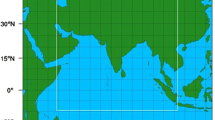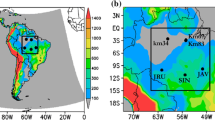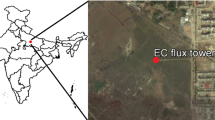Abstract
The identification of the land-atmosphere interactions as one of the key source of uncertainty in climate models calls for process-level assessment of the coupled atmosphere/land continental surface system in numerical climate models. To this end, we propose a novel approach and apply it to evaluate the standard and new parametrizations of boundary layer/convection/clouds in the Earth System Model (ESM) of Institut Pierre Simon Laplace (IPSL), which differentiate the IPSL-CM5A and IPSL-CM5B climate change simulations produced for the Coupled Model Inter-comparison Project phase 5 exercise. Two different land surface hydrology parametrizations are also considered to analyze different land-atmosphere interactions. Ten-year simulations of the coupled land surface/atmospheric ESM modules are confronted to observations collected at the SIRTA (Site Instrumental de Recherche par Télédection Atmosphérique), located near Paris (France). For sounder evaluation of the physical parametrizations, the grid of the model is stretched and refined in the vicinity of the SIRTA, and the large scale component of the modeled circulation is adjusted toward ERA-Interim reanalysis outside of the zoomed area. This allows us to detect situations where the parametrizations do not perform satisfactorily and can affect climate simulations at the regional/continental scale, including in full 3D coupled runs. In particular, we show how the biases in near surface state variables simulated by the ESM are explained by (1) the sensible/latent heat partitionning at the surface, (2) the low level cloudiness and its radiative impact at the surface, (3) the parametrization of turbulent transport in the surface layer, (4) the complex interplay between these processes. We also show how the new set of parametrizations can improve these biases.











Similar content being viewed by others
Notes
The drafts of the special issue papers can be found at http://icmc.ipsl.fr/research/international-projects/cmip5/special-issue-cmip5.
References
Adler RF, Huffman G, Chang A, Ferraro R, Xie P, Janowiak J, Rudolf B, Schneider U, Curtis S, Bolvin D, Gruber A, Susskind J, Arkin P (2003) The version 2 global precipitation climatology project (gpcp) monthly precipitation analysis (1979-present). J Hydrometeor 4:1147–1167
Bechtold P, Krueger S, Lewellen W, van Meijgaard E, Moeng C, Randall D, van Ulden A, Wang S (1996) Modeling a stratocumulus-topped pbl: intercomparison among different one-dimensional codes and with large eddy simulation. Bull Am Meteorol Soc 77(9):2033–2042
Betts A (2007) Coupling of water vapor convergence, clouds, precipitation, and land-surface processes. J Geophys Res 112(D10108). doi:10.1029/2006JD008191
Bony S, Emanuel KA (2001) A parameterization of the cloudiness associated with cumulus convection; evaluation using toga coare data. J Atmos Sci 58:3158–3318
Bosveld F, Bouten W (2001) Evaluation of transpiration models with observations over a douglas fir forest. Agric Forest Met 108:247 –264
Brooks ME, Hogan RJ, Illingworth AJ (2005) Parameterizing the difference in cloud fraction defined by area and by volume as observed with radar and lidar. Atmos Sci 62:2248–2260
Brubaker K, Dirmeyer P, Sudradjat A, Levy B, Bernal F (2001) A 36-yr climatological description of the evaporative sources of warm-season precipitation in the mississippi river basin. J Hydrometeorol 2(6):537–557
Carsel R, Parrish R (1988) Developing joint probability distributions of soil water retention characteristics. Water Resour Res 24(5):755–769
Chéruy F, Aires F (2009) Cluster analysis of cloud properties over the southern european mediterranean area in observations and a model. Mon Wea Rev 137:3161–3176
Choisnel EM, Jourdain SV, Jacquart CJ (1995) Climatological evaluation of some fluxes of the surface energy and soil water balances over France. Ann Geophys 13:666–674
Coindreau O, Hourdin F, Haeffelin M, Mathieu A, Rio C (2007) Assessment of physical parameterizations using a global climate model with stretchable grid and nudging. Mon Wea Rev 135(4):1474–1489
Couvreux F, Hourdin F, Rio C (2010) Resolved versus parametrized boundary-layer plumes. part i: a parametrization-oriented conditional sampling in large-eddy simulations. Boundary Layer Meteorol 134:441–458
De Rosnay P, Polcher J, Bruen M, Laval K (2002) Impact of a physically based soil water flow and soil-plant interaction representation for modeling large-scale land surface processes. J Geophys Res 107(D11):4118
Deardorff JW (1970) Convective velocity and temperature scales for the unstable planetary boundary layer and for Rayleigh convection. J Atmos Sci 27:1211–1213
Dirmeyer P (1995) Problems in initializing soil wetness. Bull Am Meteor Soc 76:2234–2240
Dirmeyer P, Schlosser C, Brubaker K (2009) Precipitation, recycling, and land memory: an integrated analysis. J Hydrometeorol 10(1):278–288
d’Orgeval T, Polcher J, de Rosnay P (2008) Sensitivity of the West African hydrological cycle in ORCHIDEE to infiltration processes. Hydrol Earth Syst Sci 12:1387–1401
Douville H (2010) Relative contribution of soil moisture and snow mass to seasonal climate predictability: a pilot study. Clim Dyn 34:797–818
Ducharne A, Laval K (2000) Influence of the realistic description of soil water-holding capacity on the global water cycle in a GCM. J Clim 13:4393–4413
Ducoudré N, Laval K, Perrier A (1993) SECHIBA, a new set of parametrizations of the hydrologic exchanges at the land/atmosphere interface within the LMD atmospheric general circulation model. J Clim 6(2):248–273
Dufresne J-L, Foujols M-A, Denvil S, Caubel A, Marti O, Aumont O, Balkanski Y, Bekki S, Bellenger H, Benshila R, Bony S, Bopp L, Braconnot P, Brockmann P, Cadule P, Cheruy F, Codron F, Cozic A, Cugnet D, de Noblet N, Duvel J-P, Ethé C, Fairhead L, Fichefet T, Flavoni S, Friedlingstein P, Grandpeix J-Y, Guez L, Guilyardi E, Hauglustaine D, Hourdin F, Idelkadi A, Ghattas J, Joussaume S, Kageyama M, Krinner G, Labetoulle S, Lahellec A, Lefebvre M-P, Lefevre F, Levy C, Li ZX, Lloyd J, Lott F, Madec G, Mancip M, Marchand M, Masson S, Meurdesoif Y, Mignot J, Musat I, Parouty S, Polcher J, Rio C, Schulz M, Swingedouw D, Szopa S, Talandier C, Terray P, Viovy N (2012) Climate change projections using the IPSL-CM5 Earth System Model: from CMIP3 to CMIP5 (submitted)
Emanuel K (1991) A scheme for representing cumulus convection in large-scale models. J Atmos Sci 48:2313–2329
Foken T (2008) The energy balance closure problem: an overview. Ecol Appl 18:1351–1367
Goff JA, Gratch S (1946) Low-pressure properties of water from-160 to 212 f. Trans Am Soc Heat Vent Eng 51:125–164
Grandpeix J, Lafore J (2010) A density current parameterization coupled with Emanuel’s convection scheme. Part I: the models. J Atmos Sci 67:881–897. doi:10.1175/2009JAS3044.1
Grandpeix J, Lafore J, Cheruy F (2010) A density current parameterization coupled with Emanuel’s convection scheme. Part II: 1D simulations. J Atmos Sci 67:898–922. doi:10.1175/2009JAS3045.1
Haeffelin M, Barthè s L, Bock O, Boitel C, Bony S, Bouniol D, Chepfer H, Chiriaco M, Cuesta J, Delanoë J, Drobinski P, Dufresne JL, Flamant C, Grall M, Hodzic A, Hourdin F, Lapouge F, Lemaître Y, Mathieu A, Morille Y, Naud C, Noël V, O’Hirok W, Pelon J, Pietras C, Protat A, Romand B, Scialom G, Vautard R (2005) SIRTA, a ground-based atmospheric observatory for cloud and aerosol research. Ann Geophys 23:253–275
Hourdin F, Musat I, Bony S, Braconnot P, Codron F, Dufresne JL, Fairhead L, Filiberti MA, Friedlingstein P, Grandpeix JY, Krinner G, Levan P, Li ZX, Lott F (2006) The LMDZ4 general circulation model: climate performance and sensitivity to parametrized physics with emphasis on tropical convection. Clim Dyn 27:787–813. doi:10.1007/s00382-006-0158-0
Hourdin F, Foujols M-A, Codron F, Guemas V, Dufresne J-L, Bony S, Denvil S, Guez L, Lott F, Ghattas J, Braconnot P, Marti O, Meurdesoif Y, Bopp L (2012a) Impact of the LMDZ atmospheric grid configuration on the climate and sensitivity of the IPSL-CM5A coupled model. Clim Dyn. doi:10.1007/s00382-012-1411-3
Hourdin F, Grandpeix J-Y, Rio C, Bony S, Jam A, Cheruy F, Rochetin N, Fairhead L, Idelkadi A, Musat I, Dufresne J-L, Lahellec A, Lefebvre M-P, Roehrig R (2012b) LMDZ5B: the atmospheric component of the IPSL climate model with revisited parameterizations for clouds and convection. Clim Dyn. doi:10.1007/s00382-012-1343-y
Jam A, Hourdin F, Rio C, Couvreux F (2012) Resolved versus parametrized boundary-layer plumes. part iii: a diagnostic boundary-layer cloud parameterization derived from large eddy simulations (submitted to BLM)
Jeuken A, Siegmund P, Heijboer L, Feichter J, Bengtsson L (1996) On the potential of assimilating meteorological analyses in a global climate model for the purpose of model validation. J Geophys Res 101:16939–16950
Jones PD, New M, Parker DE, Martin S, Rigor IG (1999) Surface air temperature and its changes over the past 150 years. Rev Geophys 37(2):173–199
Koster R, Dirmeyer P, Guo Z, Bonan G, Chan E, Cox P, Gordon C, Kanae S, Kowalczyk E, Lawrence D et al (2004) Regions of strong coupling between soil moisture and precipitation. Science 305(5687):1138
Koster R, Suarez M, Liu P, Jambor U, Berg A, Kistler M, Reichle R, Rodell M, Famiglietti J (2004) Realistic initialization of land surface states: impacts on subseasonal forecast skill. J Hydrometeor 5:1049–1063
Koster RD, Milly PCD (1997) The interplay between transpiration and runoff formulations in land schemes used with atmospheric models. J Clim 10:1578–1591
Krinner G, Viovy N, de Noblet-Ducoudré N, Ogée J, Polcher J, Friedlingstein P, Ciais P, Sitch S, Prentice IC (2005) A dynamic global vegetation model for studies of the coupled atmosphere-biosphere system. Global Biogeochem Cycles 19(1):GB1015. doi:10.1029/2003GB002199
Laval K, Sadourny R, Serafini Y (1981) Land surface processes in a simplified general circulation model. Geophys Astrophys Fluid Dyn 17:129–150
Long C, Ackerman T (2000) Identification of clear skies from broadband pyranometer measurements and calculation of downwelling shortwave cloud effects. J Geophys Res 105(D12):15,609–15,615
Long C, Turner D (2008) A method for continuous estimation of clear-sky downwelling longwave radiative flux developed using arm surface measurements. J Geophys Res 113:D18206
Long CN, Ackerman T, Gaustad K, Cole JNS (2006) Estimation of fractional sky cover from broadband shortwave radiometer measurements. J Geophys Res 111:D11204
Louis JF (1979) A parametric model of vertical eddy fluxes in the atmosphere. Boundary Layer Meteorol 17:187–202
Manabe S (1969) Climate and the ocean circulation i. The atmospheric circulation and the hydrology of the earth’s surface. Mon Wea Rev 97(11):739–774
Morille Y, Haeffelin M, Drobinski P, Pelon J (2007) Strat:an automated algorithm to retrieve the vertical structure of the atmosphere from single-channel lidar data. J Atmos Ocean Technol 24(5):761–775
Mualem Y (1976) A new model for predicting the hydraulic conductivity of unsaturated porous media. Water Resour Res 12(3):513–522
Neggers RAJ, Heus T, Siebesma AP (2011a) Overlap statistics of cumuliform boundary-layer clouds in large-eddy simulations. J Geophys Res 116:D21202. doi:10.1029/2011JD015650
Neggers RAJ, Siebesma AP, Heus T (2011b) Continuous single-column model evaluation at a permanent meteorological supersite. BAMS Submitted
Olson D, Dinerstein E, Wikramanayake E, Burgess N, Powell G, Underwood E, D’amico J, Itoua I, Strand H, Morrison J et al (2001) Terrestrial ecoregions of the world: a new map of life on earth. BioScience 51(11):933–938
Philips TJ et al (2004) Evaluating parameterizations in general circulation models: climate simulation meets weather prediction. Bull Am Meteor Soc 85:1903–1915
Randall D, Xu K, Somerville R, Lacobellis S (1996) Single-column models and cloud ensemble models as links between observations and climate models. J Clim 9(8):1683–1697
Reichler T, Kim J (2008) How well do coupled models simulate today’s climate. Bull Am Meteorol Soc 89(3):303–311
Reynolds C, Jackson T, Rawls W (2000) Estimating soil water-holding capacities by linking the food and agriculture organization soil map of the world with global pedon databases and continuous pedotransfer functions. Water Resour Res 36(12):3653–3662
Rio C, Hourdin F (2008) A thermal plume model for the convective boundary layer: representation of cumulus clouds. J Atmos Sci 65(2):407–425. doi:10.1175/2007JAS2256.1
Rio C, Hourdin F, Grandpeix JY, Lafore JP (2009) Shifting the diurnal cycle of parameterized deep convection over land. Geophys Res Lett 36:L07809. doi:10.1029/2008GL036779
Rio C, Hourdin F, Couvreux F, Jam A (2010) Resolved versus parametrized boundary-layer plumes. Part II: continuous formulations of mixing rates for mass-flux schemes. Boundary Layer Meteorol 135:469–483. doi:10.1007/s10546-010-9478-z
Rio C, Grandpeix J-Y, Hourdin F, Guichard F, Couvreux F, Lafore J-P, Fridlind A, Mrowiec A, Bony S, Rochetin N, Roehrig R, Idelkadi A, Lefebvre M-P, Musat I (2012) Control of deep convection by sub-cloud lifting processes: the ALP closure in the LMDZ5B general circulation model. Clim Dyn (submitted)
Schär C, Lüthi D, Beyerle U, Heise E (1999) The soil-precipitation feedback: a process study with a regional climate model. J Clim 12(3):722–741
Seneviratne D, SIand Lüthi, Litschi M, Schär C (2006) Land-atmosphere coupling and climate change in europe. Nature 443:205–209
Seneviratne SI, Corti T, Davin EL, Hirschi M, Jaeger EB, Lehner I, Orlowsky B, Teuling AJ (2010) Investigating soil moistureclimate interactions in a changing climate: a review. Earth Sci Rev 99(3–4):125–161. doi:10.1016/j.earscirev.2010.02.004
Thiessen A (1911) precipitation averages for large areas. Mon Wea Rev 39:1082–1084
van Genuchten M (1980) A closed-form equation for predicting the hydraulic conductivity of unsaturated soils. Soil Sci Soc Am J 44(5):892–898
Yamada T (1983) Simulations of nocturnal drainage flows by a q 2 l turbulence closure model. J Atmos Sci 40:91–106
Acknowledgments
The Météo-France station data collected in the vicinity of the SIRTA site have been made available to us thanks to the DEPHY/Insu/LEFE french project. The research leading to these results has received funding from the European Union, Seventh Framework Programme (FP7/2007–2013) under grant agreement n 244067, EUCLIPSE. Aurélien Campoy was supported by a grant from Région Ile-de-France. We extend our acknowledgments to the technical and computer staff (particularly to Ludmila Klenov) of SIRTA observatory for taking the observations and compile them in the SCTD data set. The authors acknowledge ECMWF for providing the data and the ClimServ team from the ESPRI/IPSL data center for their help in accessing and formating the data.
Author information
Authors and Affiliations
Corresponding author
Additional information
This paper is a contribution to the special issue on the IPSL and CNRM global climate and Earth System Models, both developed in France and contributing to the 5th coupled model intercomparison project.
Rights and permissions
About this article
Cite this article
Cheruy, F., Campoy, A., Dupont, JC. et al. Combined influence of atmospheric physics and soil hydrology on the simulated meteorology at the SIRTA atmospheric observatory. Clim Dyn 40, 2251–2269 (2013). https://doi.org/10.1007/s00382-012-1469-y
Received:
Accepted:
Published:
Issue Date:
DOI: https://doi.org/10.1007/s00382-012-1469-y




